Yakisoba is a classic Japanese stir-fried noodle dish that’s seasoned with a sweet and savory sauce similar to Worcestershire sauce. Use any proteins you like—pork, chicken, shrimp, or calamari. For vegetarians, just swap it with tofu or shiitake mushrooms.
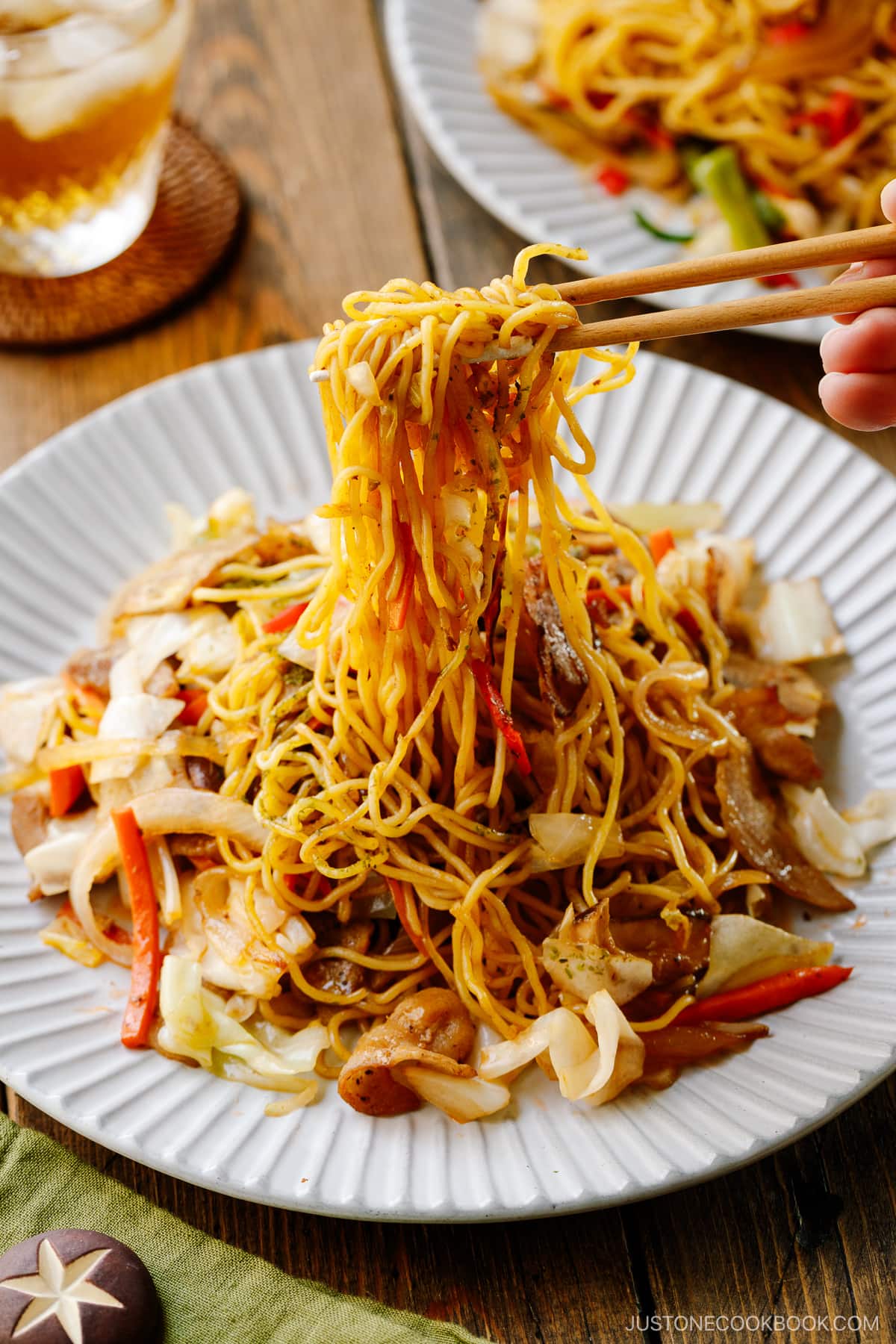
Growing up in Japan, yakisoba (Japanese stir-fried noodles) was a staple of our weekend lunches. My mom and I would prepare the ingredients, and everyone gathered around the electric griddle and cooked the noodles together. There were so many memories surrounding the dish that I always associate yakisoba with weekend lunches.
You can easily make yakisoba at home, customizing it with ingredients like chicken, shrimp, calamari, to make it your style. Or try it with mushrooms or tofu for a simple vegetarian version!
Table of Contents
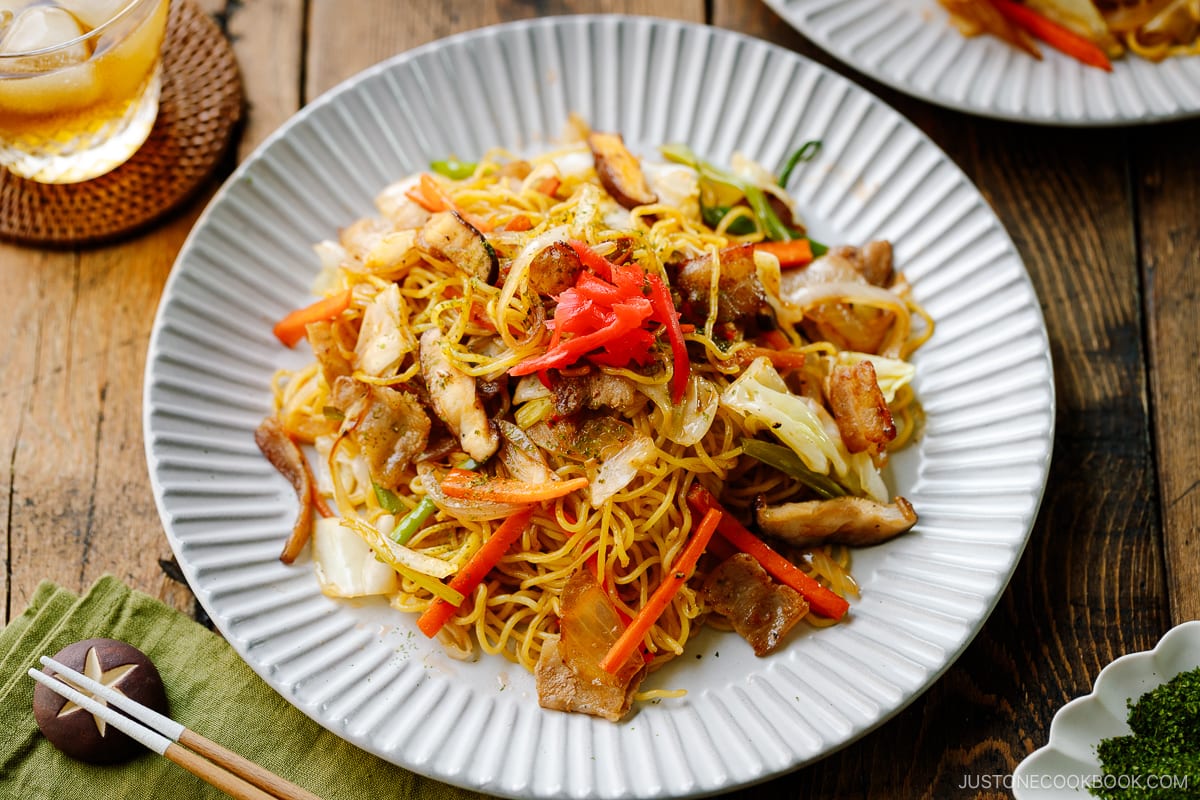
What is Yakisoba?
Yakisoba (焼きそば) is a stir-fried noodle dish that typically includes meat or seafood, as well as vegetables such as cabbage, carrots, onions, and bean sprouts. These ingredients are all cooked together in a thick, sweet-savory sauce, and the final dish is usually topped with aonori (dried green seaweed) and red pickled ginger for added flavor.
A Brief History
According to food history researcher Shogo Shiozaki, this popular street food originated in Asakusa during the Taisho era, where Chinese noodle factories were first established.
Interestingly, yakisoba was actually created as a clever variation of okonomiyaki, a Japanese savory pancake. If you examine both dishes closely, you’ll notice similarities in the ingredients used, including meat/seafood, vegetables, and a British-style sauce! The key distinction is that yakisoba replaces the flour batter used in okonomiyaki with Chinese noodles. In fact, if you visit long-standing okonomiyaki restaurants in Tokyo, you’ll often find yakisoba offered as part of their menu.
Yakisoba quickly gained popularity, especially among young children who loved its delicious fried noodles. Originally a staple of food stalls, it eventually became a common item at Teishoku-ya (Japanese diners) and even at candy stores known as dagashi-ya (駄菓子屋). Due to the ease of setting up an iron plate teppan (鉄板), yakisoba food stalls became popular at school events, festivals, fairs, and more. Today, yakisoba is considered an iconic Japanese street food.
In the US, you can commonly find yakisoba on the menus of Japanese grill teppanyaki restaurants or sold by street vendors at Japanese Obon festivals or cherry blossom festivals.
Is Yakisoba Made with Buckwheat Noodles?
As “soba” is a type of Japanese buckwheat noodles, a lot of people have asked me if yakisoba uses the same noodle.
To clarify, the word “soba” in Japanese is an umbrella term to describe noodles of any type, such as chuka soba for ramen and yakisoba in this instance.
Yakisoba does not use buckwheat soba noodles. Instead, it uses mushi chukamen (蒸し中華麺), which are steamed Chinese-style noodles made from wheat flour, kansui, and water. These noodles have a yellowish color due to the kansui but are not egg noodles. They share a texture similar to ramen noodles and are pre-steamed for quick reheating.
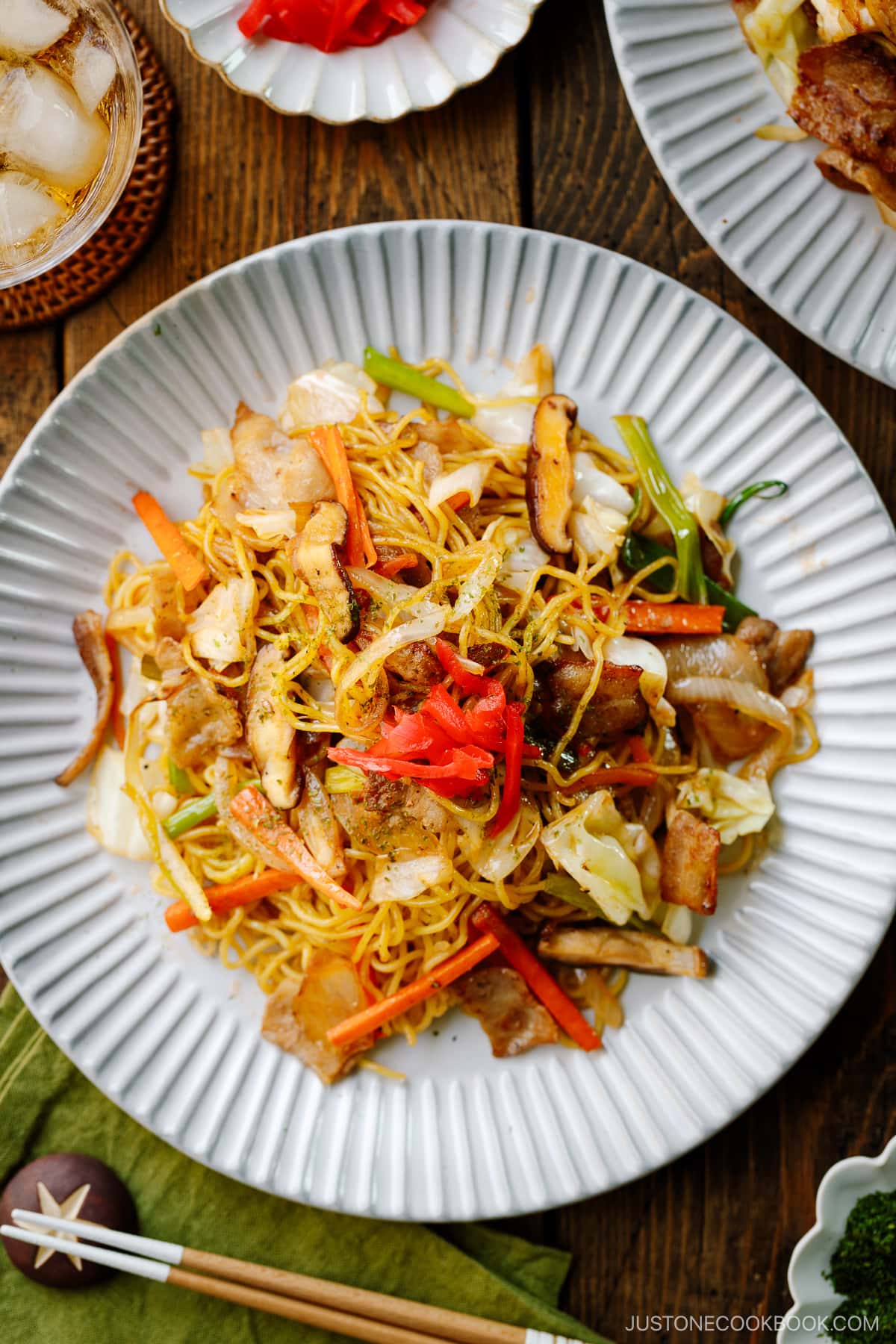
How to Make Yakisoba
The Ingredients You’ll Need
- Yakisoba noodles: These are Chinese-style noodles made with wheat flour (more information below).
- Vegetables: I use thinly sliced yellow onion, green onion, julienned carrot, some sliced shiitake mushrooms, and chopped cabbage. These veggies work great for a stir-fry. You can also use bok choy or thin strips of bell pepper.
- Protein(s): I use sliced pork belly in this recipe as it is the most common choice of meat to make yakisoba in Japan. However, you can switch it up with any protein like shrimp, calamari, chicken, and firm tofu.
- Oil: Any neutral-tasting oil will work.
- Yakisoba Sauce: Worcestershire sauce, oyster sauce (or vegetarian stir fry sauce), ketchup, soy sauce, and sugar. Adjust the amount to suit your taste.
- Optional toppings: aonori (powdered green seaweed) and beni shoga (red pickled ginger). Some people also like to top the noodles with katsuobushi (shaved bonito flakes).
The Cooking Steps
- Cut the ingredients into bite-size pieces.
- Warm up the noodles and transfer them to a dish.
- Cook the protein, followed by the tough vegetables, and then the soft vegetables.
- Put back the noodles and season them with Yakisoba Sauce.
- Toss them all together and serve.
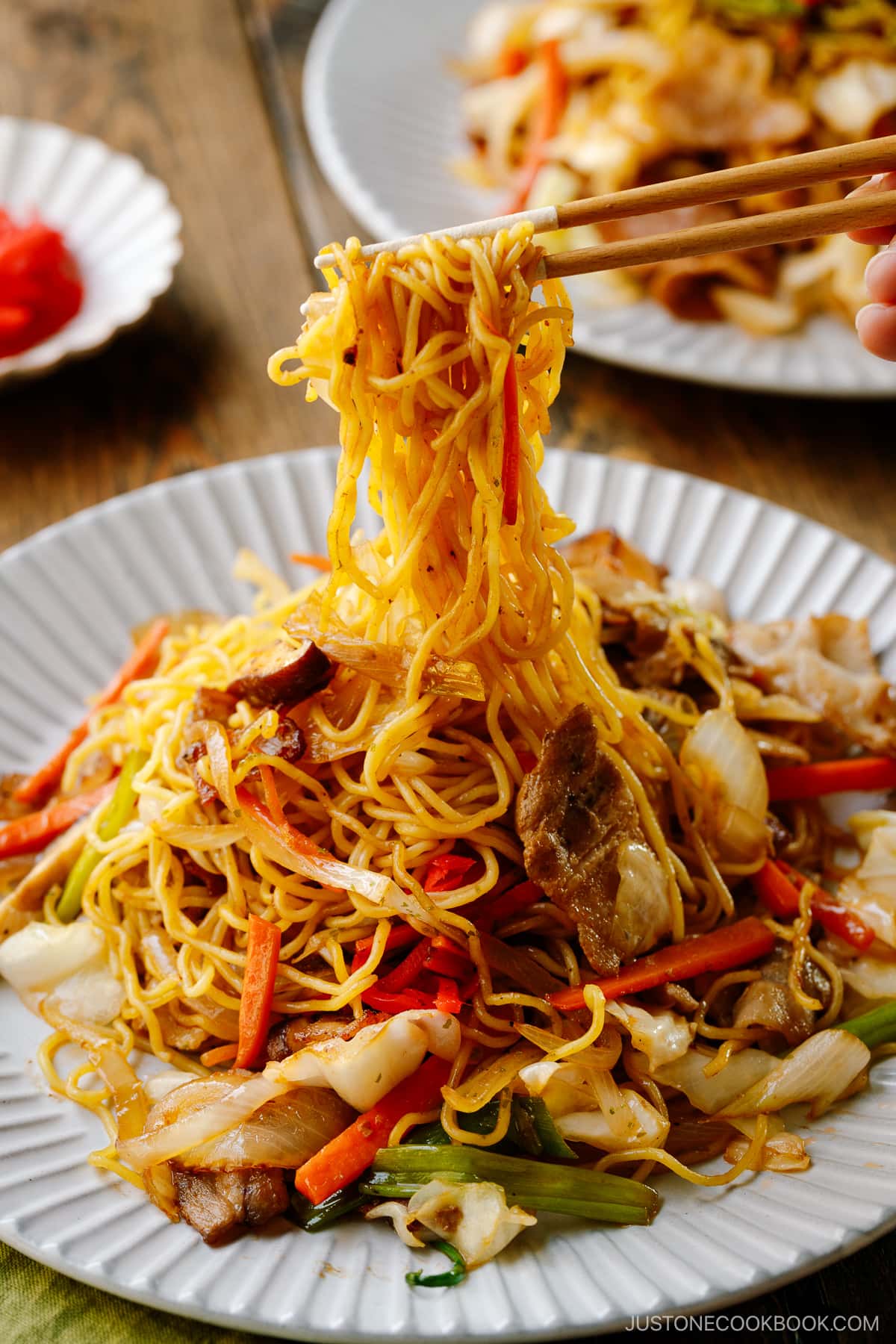
Ingredient Variations
My mom often changes up the ingredients when she makes yakisoba. In addition to pork belly slices, she sometimes uses Japanese sausages and ground pork, and my favorite is the combination of ground pork and squid/calamari. For extra crunch and fiber, she also throws in Chinese chives (nira in Japanese) and bean sprouts.
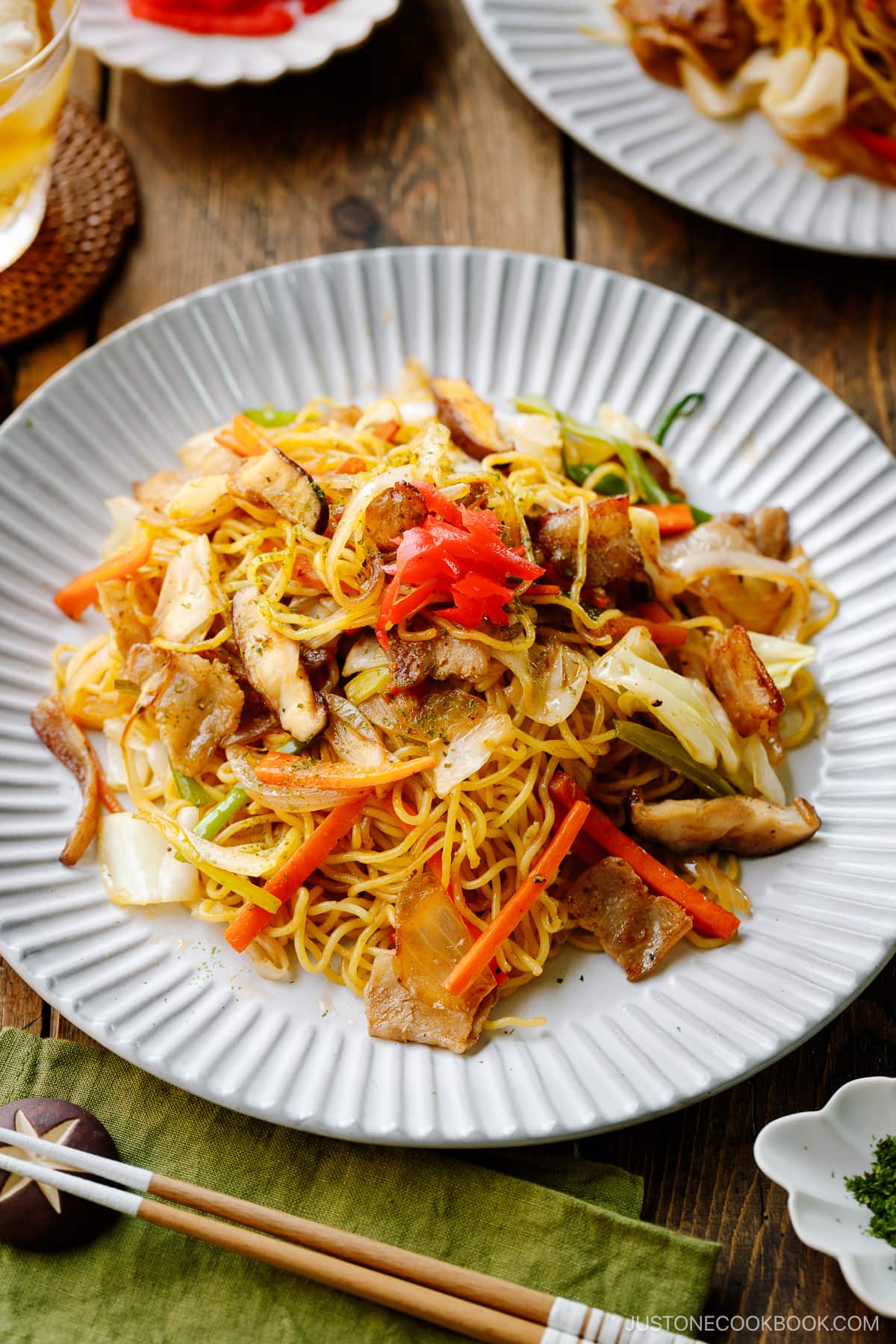
Where to Buy Yakisoba Noodles
The two popular yakisoba noodle brands are Myojo (明星) and Maruchan (マルちゃん), and each package comes with three packs of yakisoba noodles. The noodles are already steamed, coated with oil, and packed tightly in the packets.
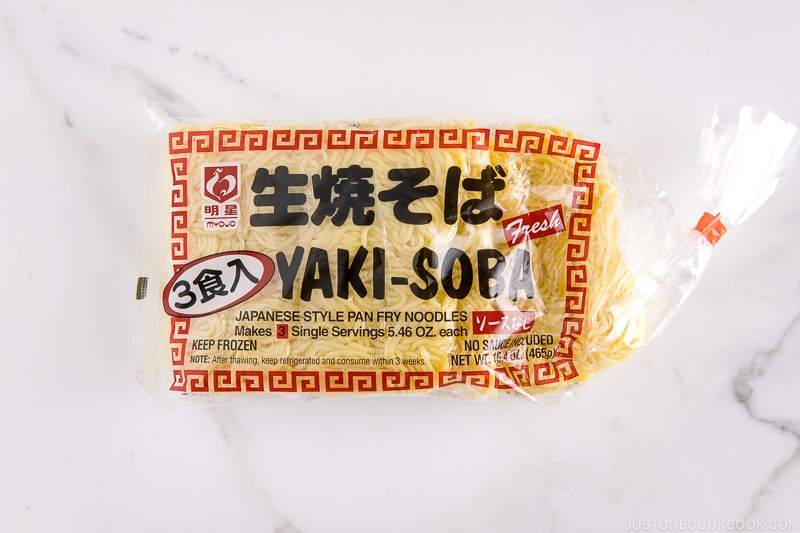
I recommend using the Myojo brand (see the picture above). Maruchan, if frozen, tends to break into pieces when defrosted. In Japan, yakisoba noodles are never sold frozen. However, these noodles don’t last too long and they are often sold frozen outside of the US.
You can purchase them in Japanese, Korean, and Chinese grocery stores, and they are either in the refrigerated or freezer section.
How to Make Yakisoba Sauce
The popular Otafuku brand offers Yakisoba sauce (see below), but my family actually likes making yakisoba sauce from scratch.
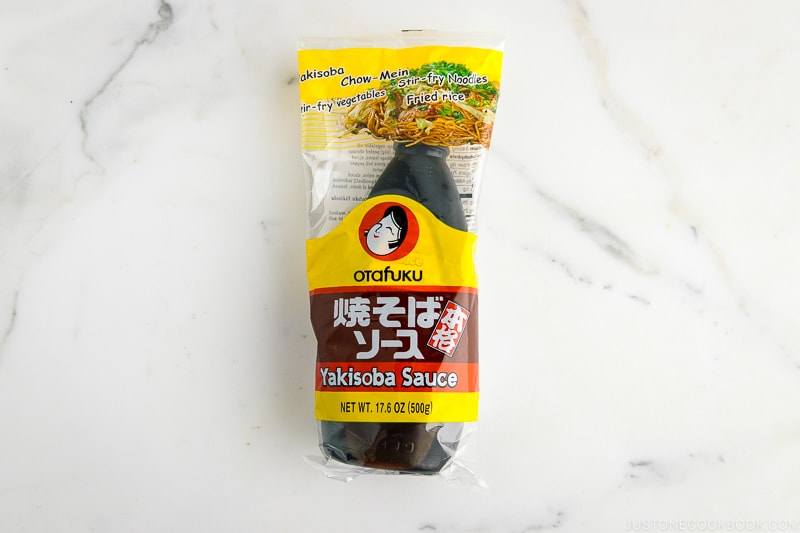
Homemade yakisoba sauce is made with common condiments from American grocery stores, such as Worcestershire sauce, ketchup, oyster sauce, and soy sauce. You can adjust the sauce as you like, so your yakisoba tastes slightly different each time.
My homemade recipe below is the exact amount needed for the ingredients below. I recommend doubling the sauce in case you end up adding more ingredients. You don’t want the noodles to be bland.
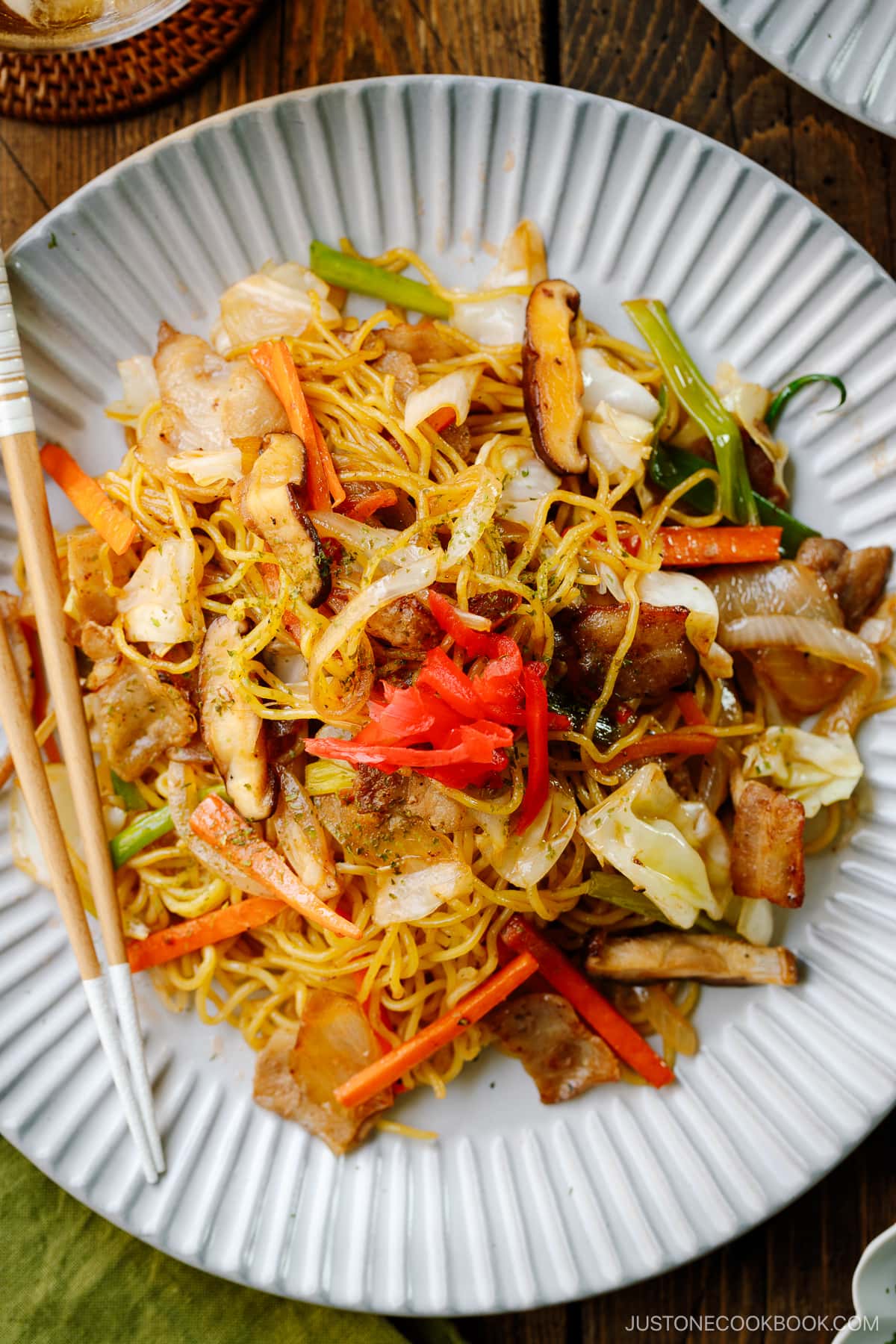
Cooking Tips
1. Use a large cookware.
It’s important to use a griddle, wok, or frying pan with a large cooking space so that your ingredients have direct contact with the hot surface. The nice char will add fantastic flavors and give the noodles a “street food” character.
My griddle is from Thermador and I can’t find the exact model. You can use a similar griddle like this or this when making yakisoba at home. It is also fantastic for Okonomiyaki and all sorts of pancakes!
2. Cook vegetables in stages.
When it comes to any stir-fried dishes, we want to retain the fresh texture and crunch of the vegetables. So it is important to stir-fry the hard vegetables first before adding other softer ingredients. Each vegetable has a different cooking time, so cook quickly and in succession. Do not throw everything at once. Also, do not overcook as wilted veggies are a no-no for stir-fries.
3. Don’t add too many ingredients.
This is after all a noodle dish. It’s tempting to toss in lots of veggies or extra meat. Adding too many ingredients will end up steaming the noodles. You need to let the steam escape, so the noodles are not wet, and preferably make it as dry and crispy as possible. If you prefer drier-style noodles (I prefer mine to have some moisture), fry the noodles first, then transfer them out before cooking the vegetables and meat/ tofu. That way, you don’t have to cook the noodles later on, and the noodles will still stay crispy.
4. Loosen up the noodles first.
I recommend loosening the noodles quickly before mixing with the stir-fried ingredients. This way, you can mix with the other ingredients easily. If you don’t, you will most likely break up the noodles into small pieces on the griddle or wok.
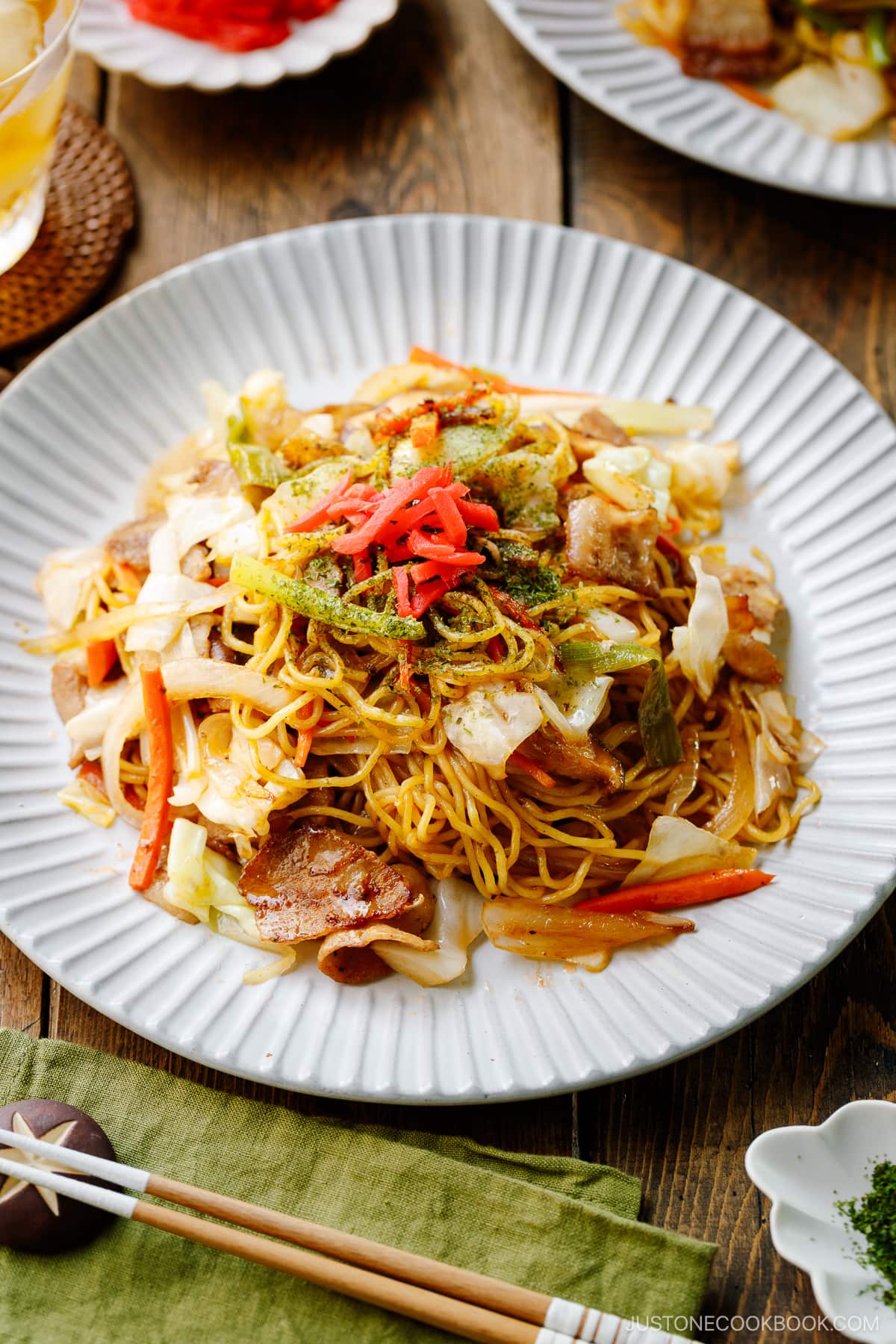
Frequently Asked Questions
Can I use ramen noodles instead of yakisoba noodles?
Yakisoba noodles are already steamed and greased. When you reheat them, the texture of the noodles will become tender.
In a pinch, you can use fresh Chinese stir-fried noodles from Asian grocery stores.
Can I make chicken yakisoba?
I get this question often as chicken is the most popular protein. However, in Japan, chicken is not the common protein choice for yakisoba, but you can certainly use it. I recommend chicken thighs rather than breasts because thighs are more flavorful and don’t get dry easily.
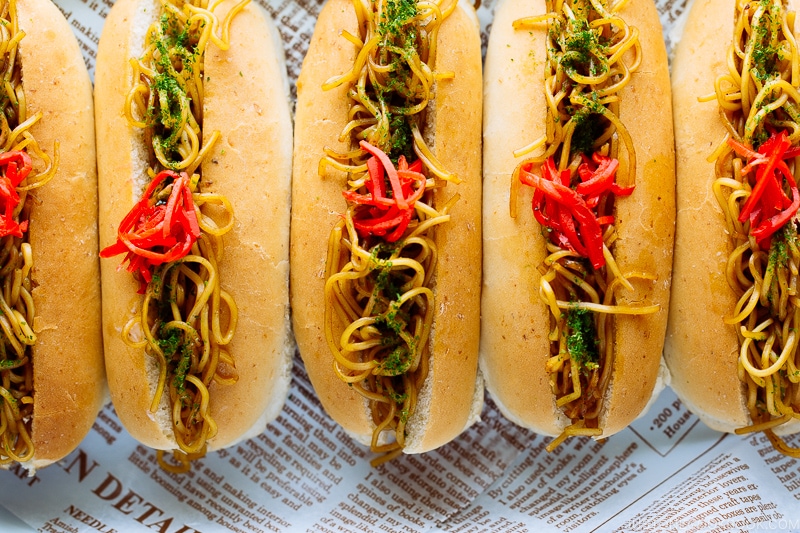
Varieties of Yakisoba
There are also a few different ways of serving stir-fried noodles:
- Modern-Yaki – When the yakisoba noodles are used as a base layer ingredient for okonomiyaki, we call this savory Japanese pancake Modern-Yaki.
- Yakisoba Pan or Yakisoba Dog – It’s basically a hot dog bun stuffed with yakisoba!
- Omusoba – Omelette stuffed with yakisoba.
- Yaki Udon – Originated in the Fukuoka Prefecture, yaki udon uses thick chewy udon noodles instead of Chinese-style wheat noodles.
- Okinawan-style yakisoba – Sometimes features ingredients such as Spam, chopped hot dogs, and sliced hams.
- Gluten-free Yakisoba – Use glass noodles instead of wheat noodles.
More Delicious Japanese Noodle Recipes:
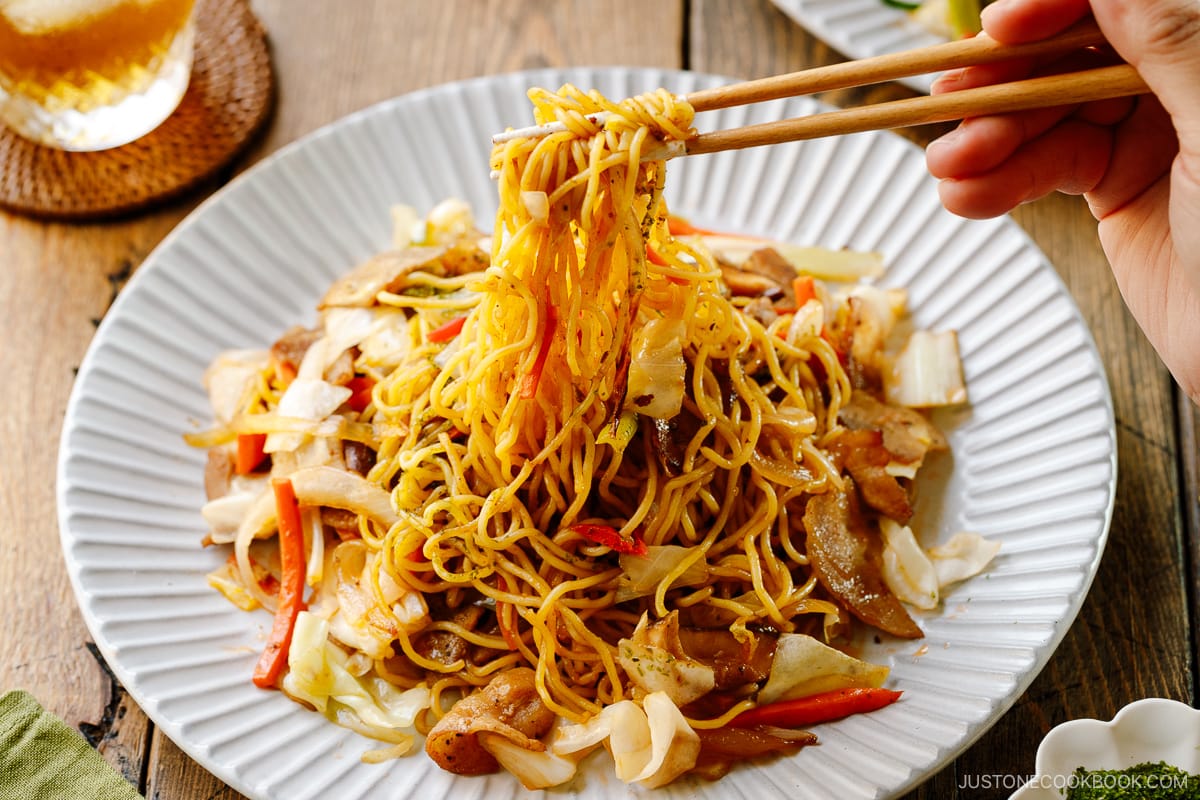
Wish to learn more about Japanese cooking? Sign up for our free newsletter to receive cooking tips & recipe updates! And stay in touch with me on Facebook, Pinterest, YouTube, and Instagram.
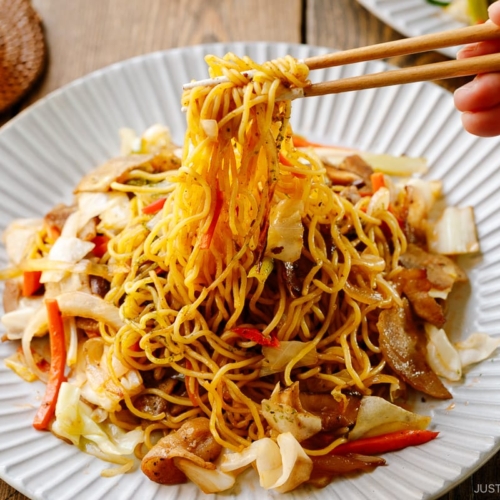
Yakisoba (Japanese Stir-Fried Noodles)
Video
Ingredients
For the Yakisoba Sauce
- ¼ cup Worcestershire sauce (use vegan Worcestershire sauce for vegan)
- 4 tsp oyster sauce (use Lee Kum Kee Vegetarian Stir-Fry Sauce for shellfish allergies or vegetarian)
- 4 tsp ketchup
- 2 tsp soy sauce
- 2 tsp sugar (plus more, to taste)
For the Yakisoba
- ¾ lb sliced pork belly (or your choice of meat/seafood/mushrooms/veggies)
- ½ onion (5 oz, 142 g)
- 4 inches carrot (3.5 oz, 100 g)
- ¼ head green cabbage (small; ½ lb, 227 g)
- 2 green onions/scallions
- 3 shiitake mushrooms (1.4 oz, 40 g)
- 2 Tbsp neutral oil (plus more, if needed)
- 3 servings yakisoba noodles (pre-steamed; one package contains 3 servings, 16–17 oz, 454–480 g)
- freshly ground black pepper
- ⅓ cup yakisoba sauce (plus more, to taste; from the recipe above)
For the Toppings (optional)
Instructions
- Gather all the ingredients. Freeze the pork belly slices for 10 minutes so that it‘s easier to cut. Tip: For the sauce, I recommend doubling the recipe, just in case. It‘s hard to measure the vegetables and meat precisely, and if you end up adding more ingredients, you‘ll need more sauce so the yakisoba is flavorful.

To Make the Sauce (yields ⅓ cup, 80 ml)
- Whisk together all the ingredients for the Yakisoba Sauce: ¼ cup Worcestershire sauce, 4 tsp oyster sauce, 4 tsp ketchup, 2 tsp soy sauce, and 2 tsp sugar. At this point, it‘s important to taste the sauce and add more sugar, if needed. For example, some ketchup is sweeter than others while some Worcestershire sauce is less sour than others. Set it aside.

To Prepare the Ingredients
- Remove ¾ lb sliced pork belly from the freezer. Cut the pork belly slices into 1-inch (2.5-cm) pieces.

- Cut ½ onion into ¼-inch (6-mm) slices.

- Cut 4 inches carrot into 2-inch slabs. Then, cut them into julienne strips 2 inches (5 cm) long.

- Remove the core from ¼ head green cabbage. First, cut the cabbage wedge into slices 1 inch (2.5 cm) wide.

- Then, cut the slices into bite-sized pieces.

- Chop 2 green onions/scallions into 2-inch (5-cm) pieces. Cut any thick, white parts of the green onions in half lengthwise.

- Remove the stems from 3 shiitake mushrooms. Cut the caps into ¼-inch (6-mm) slices.

To Cook the Noodles
- Heat a griddle (I use a similar one; you can use a large frying pan or wok) on medium heat. When it‘s hot, add 2 Tbsp neutral oil. Then, add 3 servings yakisoba noodles. Tip: The pre-steamed noodles will come pressed together into squares. You do not need to loosen them before placing them on the griddle.

- When the bottom side of the noodles is heated, flip them. The goal here is to loosen up the noodles gently without breaking them into short pieces. If you force them to separate, the noodles will break up. So be patient here.

- With chopsticks, gradually loosen up the noodles. Once they have loosened up completely, transfer them to a plate.

To Cook the Yakisoba
- To the hot griddle, add the pork belly slices and separate the chunks into a single layer. (If you are not using pork belly, add 1 Tbsp oil to the griddle before adding your choice of protein.) Season with freshly ground black pepper.

- Stir-fry until the pork belly is no longer pink.

- Next, add the onion slices to the griddle. Stir to cook for 1–2 minutes, separating the onion layers as you stir-fry.

- Add the carrots and cook for another 1–2 minutes.

- Add the cabbage and shiitake mushrooms. Cook until they are almost tender.

- Lastly, add the green onions and cook for 1 minute.

- Put the yakisoba noodles on top of the protein and vegetables on the griddle. Then, drizzle ⅓ cup yakisoba sauce on the noodles. Taste the noodles and add more sauce, if desired.

- With a pair of tongs, toss to combine the noodles with the sauce and other ingredients. Keep an eye on the noodles as they may stick to the skillet/wok. When the sauce is well distributed and the noodles are warmed through, transfer the yakisoba to individual plates.

To Serve
- Garnish with optional aonori (dried green laver seaweed) and pickled red ginger (beni shoga or kizami beni shoga). Serve immediately.

To Store
- You can store any leftovers in an airtight container and store in the refrigerator for up to 3 days and in the freezer for a month. Thaw overnight in the refrigerator and reheat in the microwave to warm.
Nutrition
Update: The post was originally published on April 6, 2011. It’s been republished with a new video, new images, and updated content on October 27, 2023.
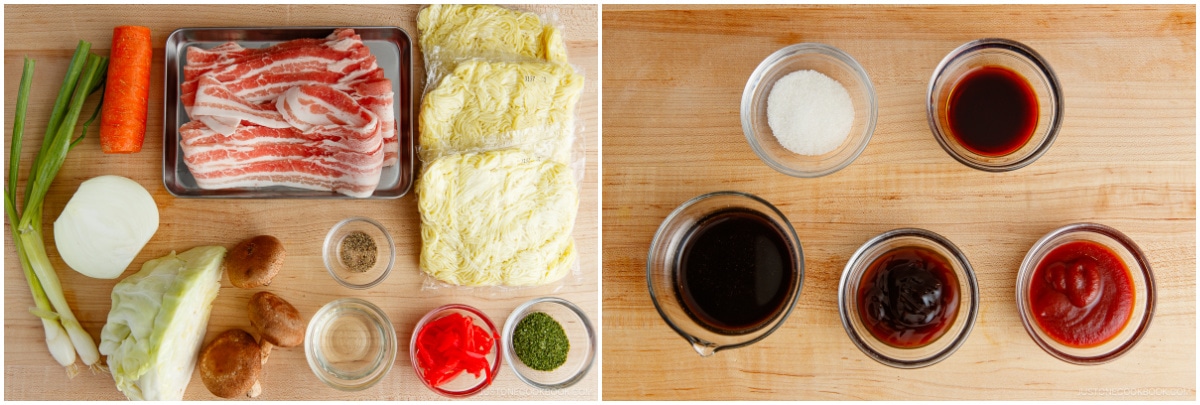
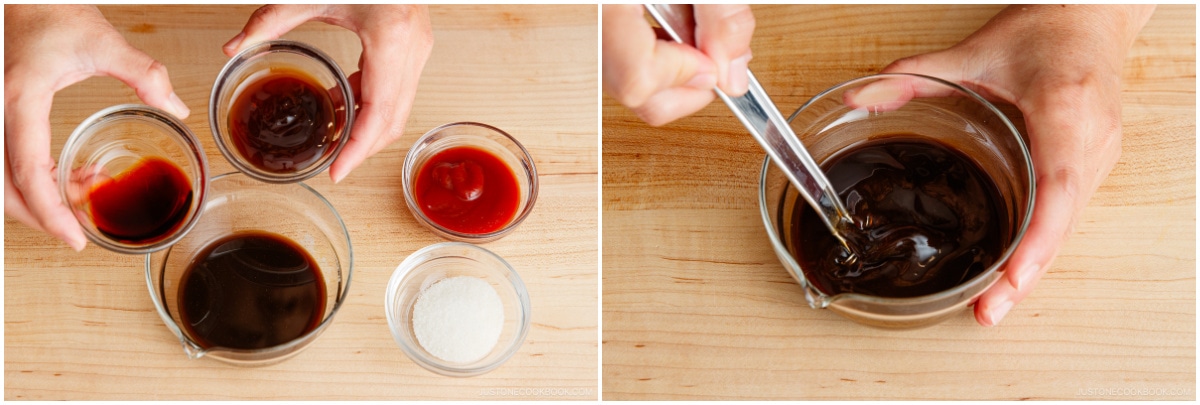
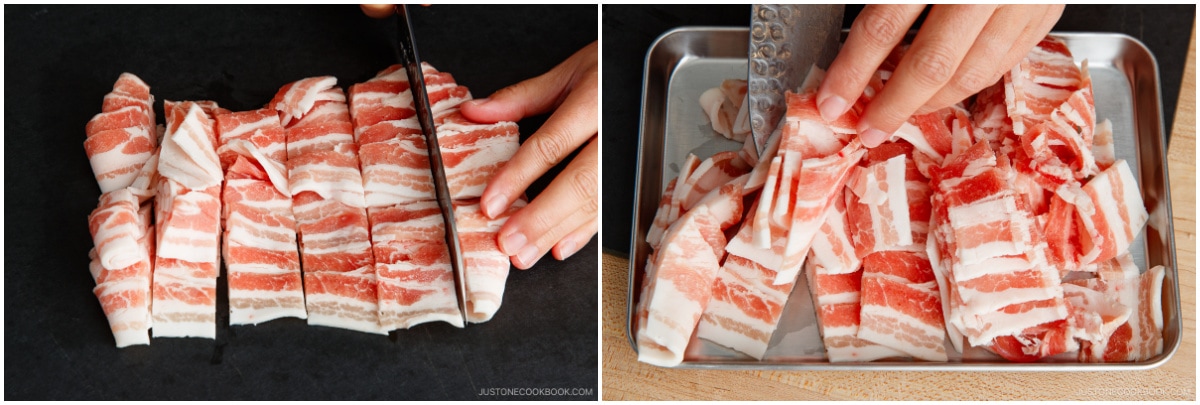
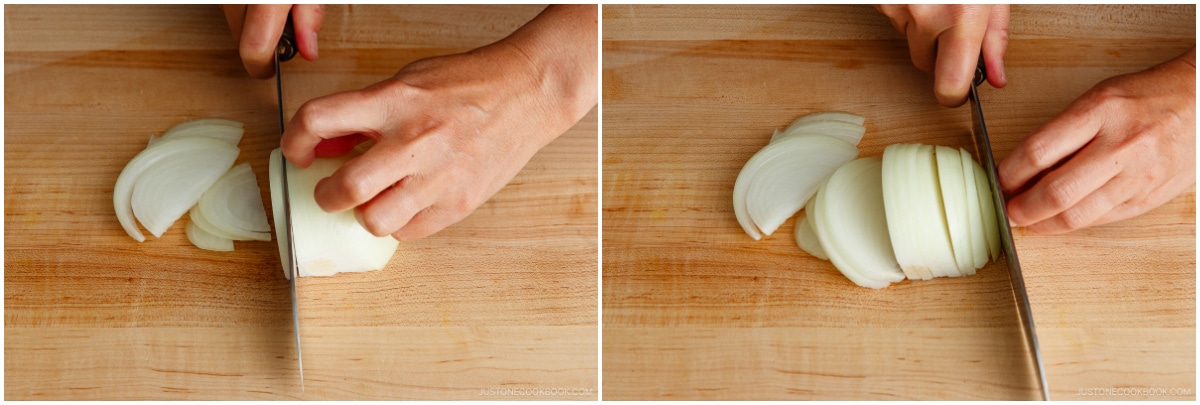
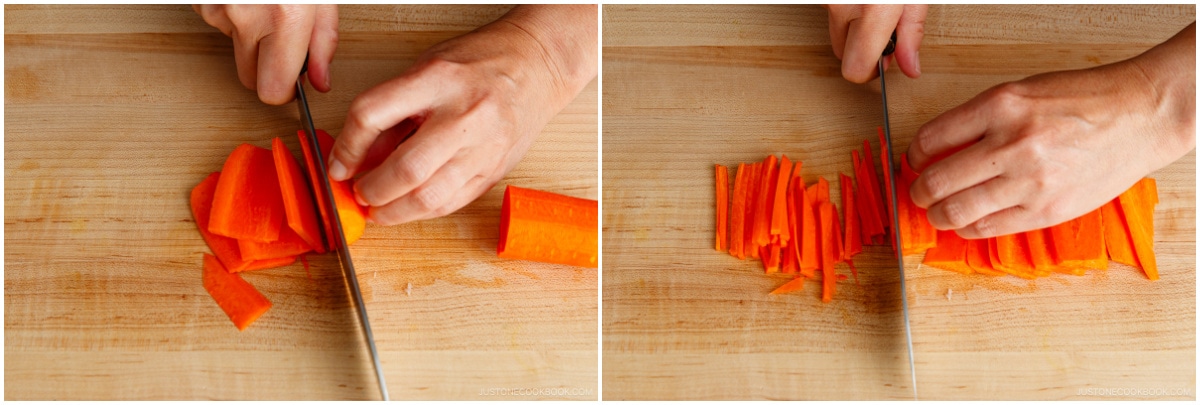
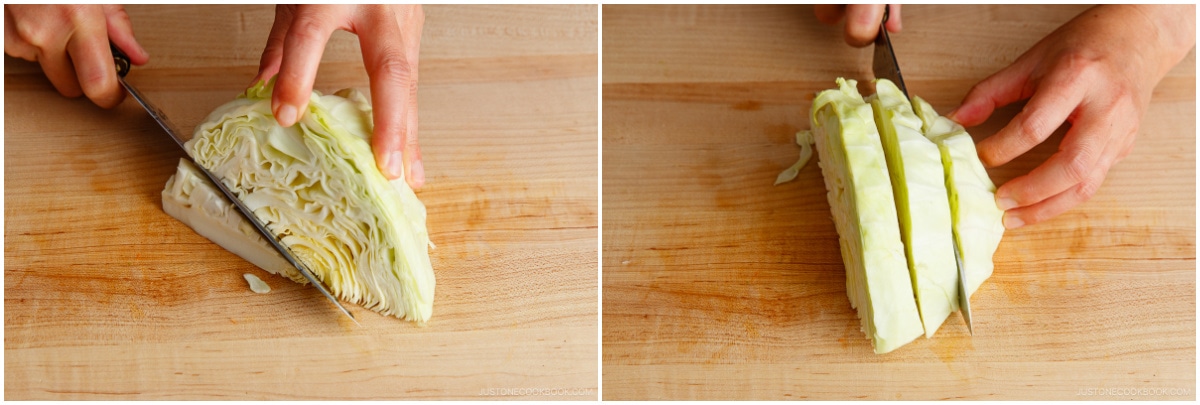
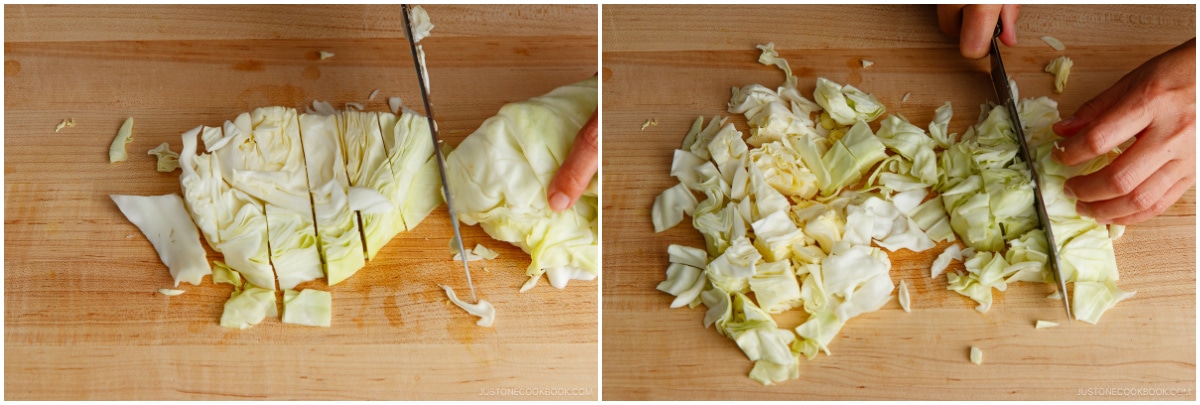
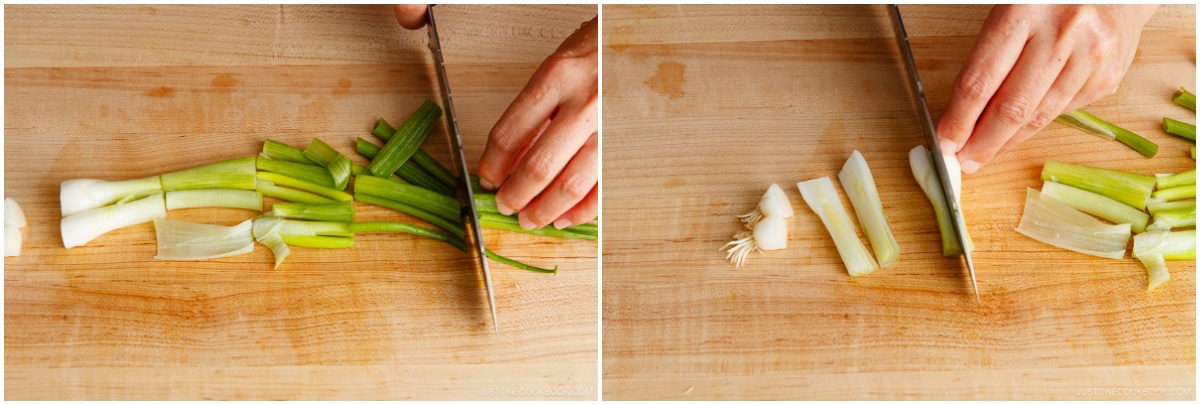
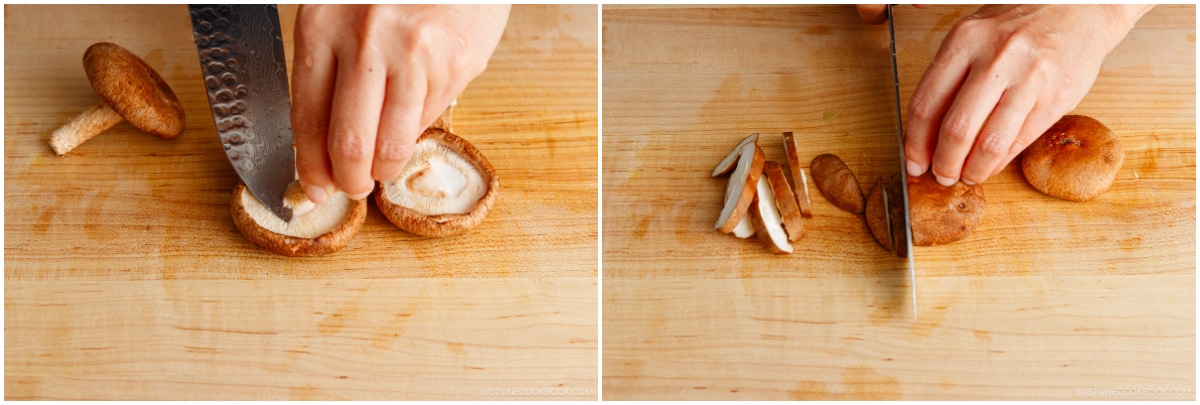
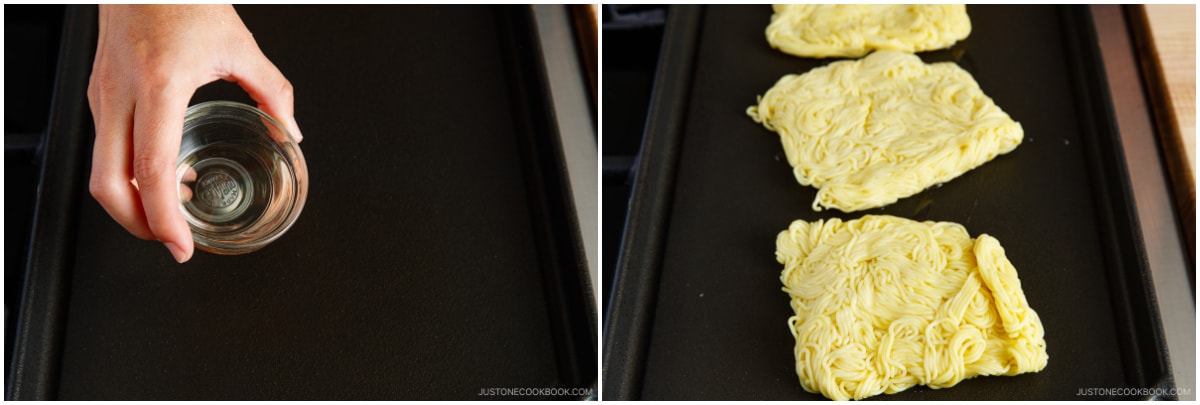
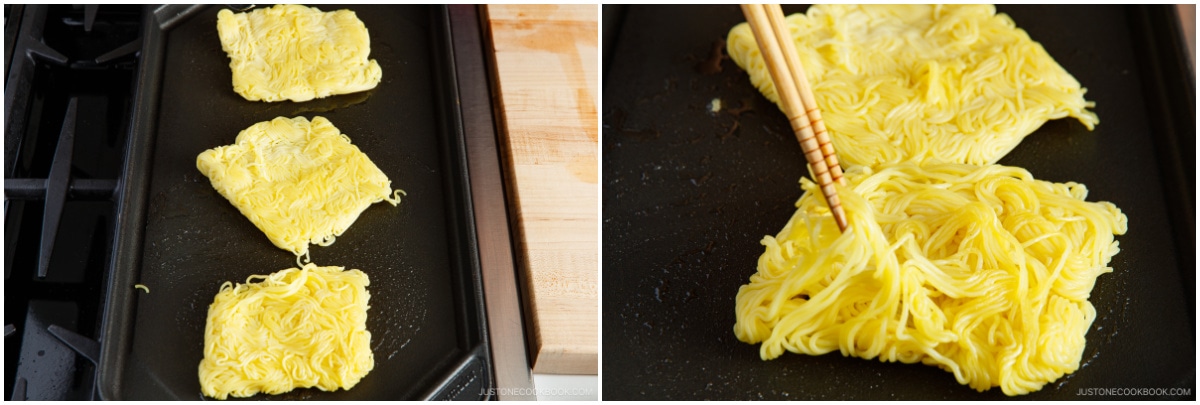
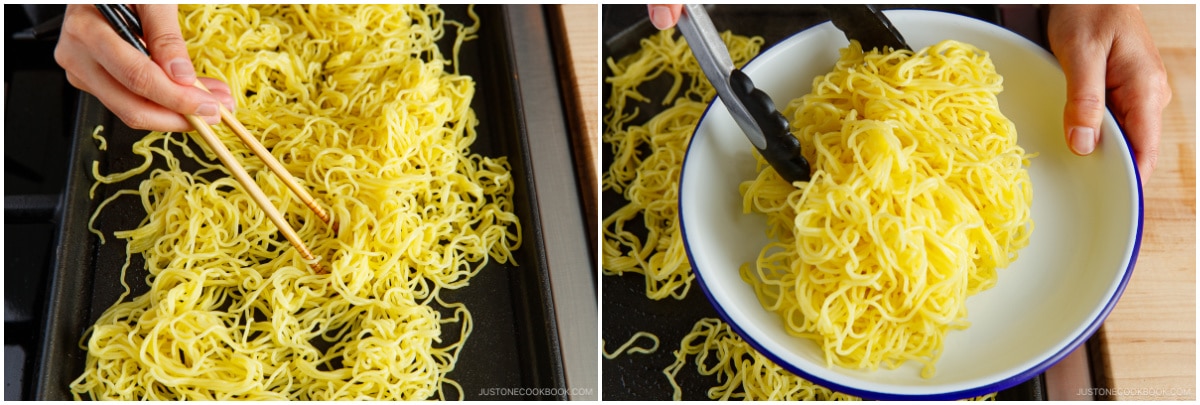
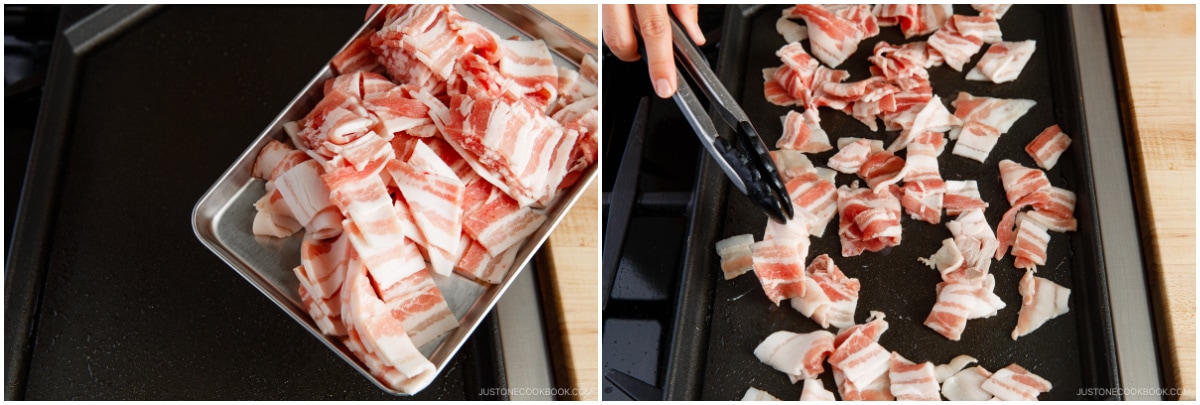
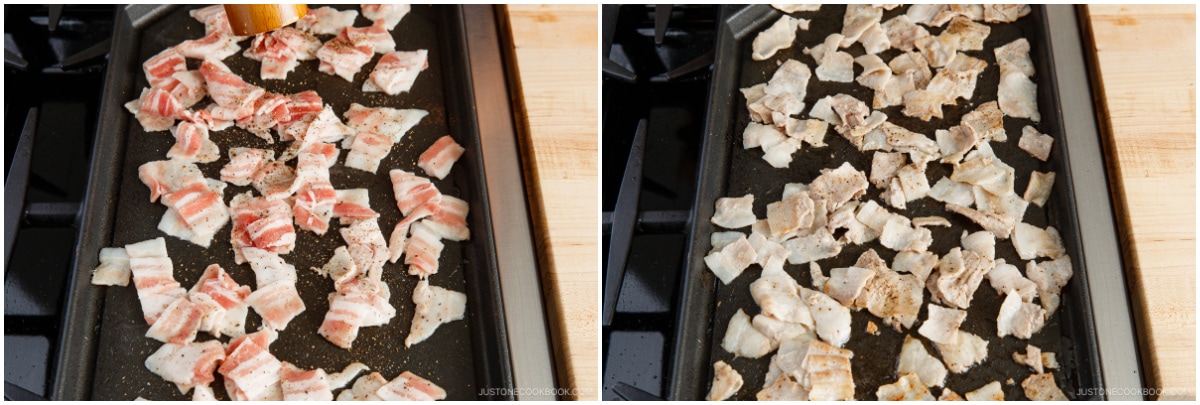
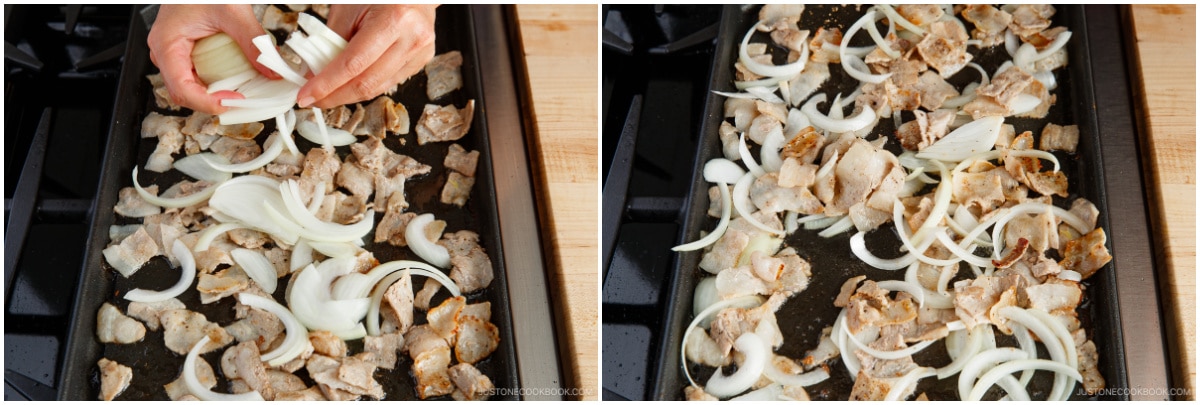
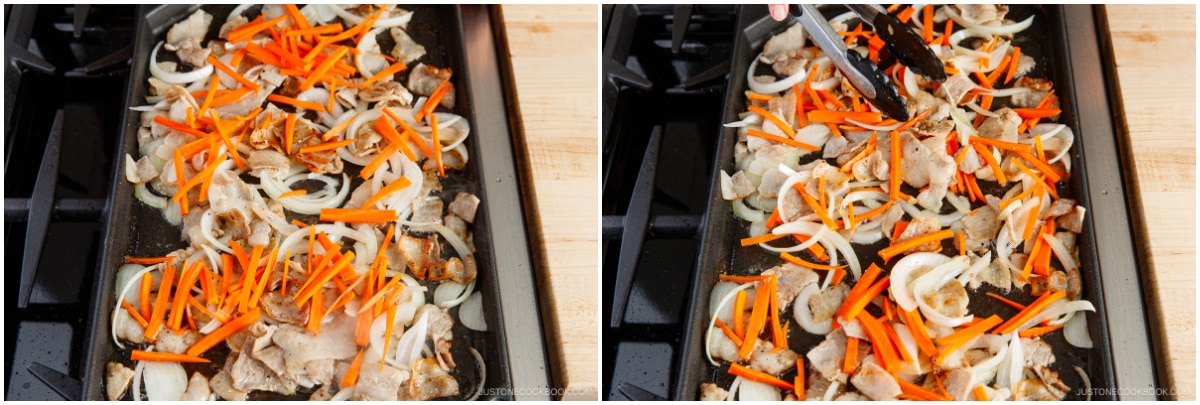
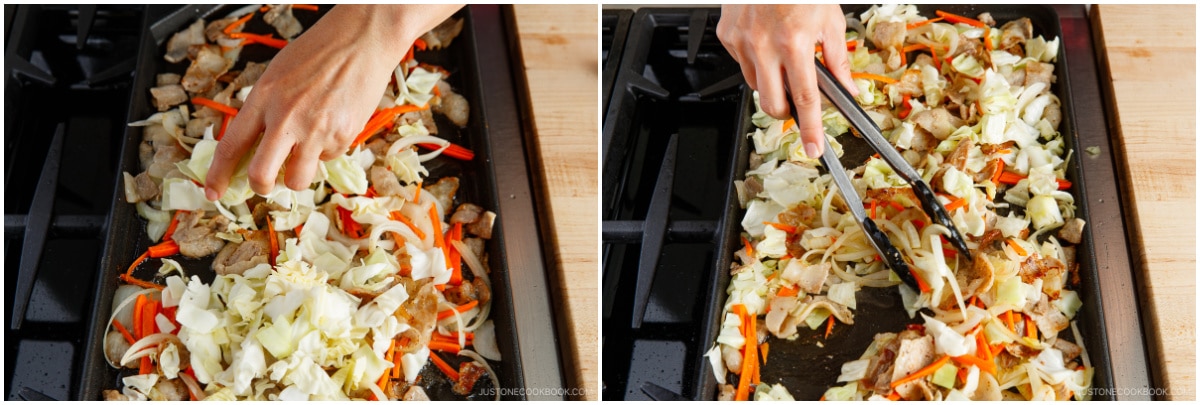
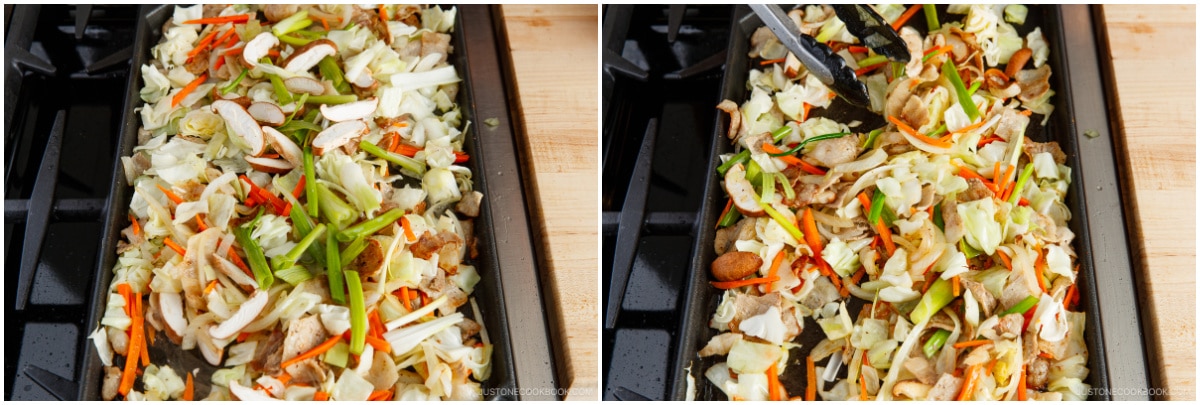
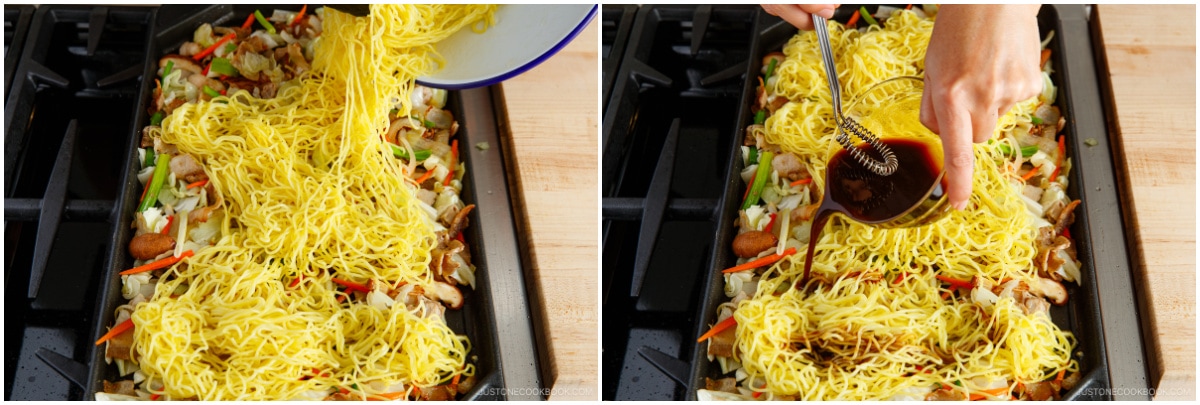
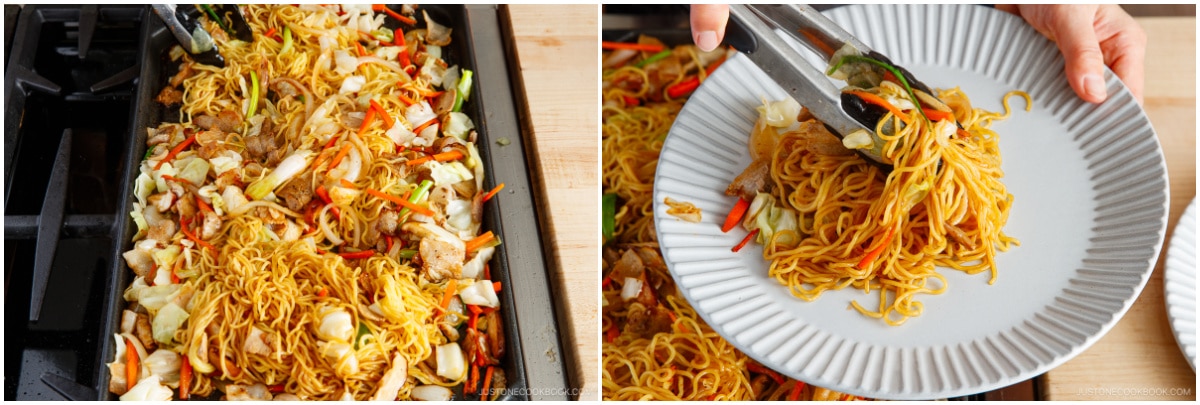
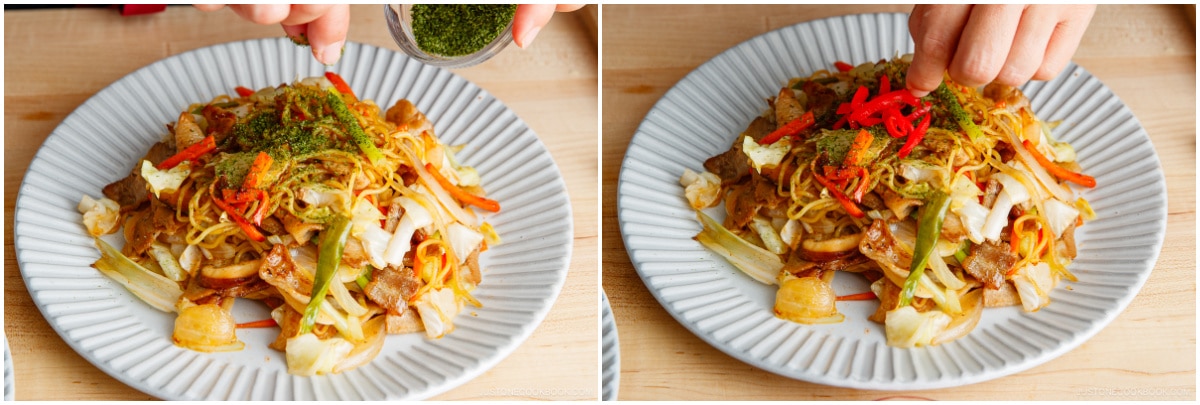










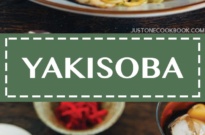
Delicious! Made this with coleslaw mix and chicken, otherwise followed recipe exactly. Great flavour! The sauce is the maker of this dish.
Hi Beverly! Thank you so much for trying Nami’s recipe and sharing your cooking experience with us.
We are so happy to hear that you enjoyed Yakisoba! Happy Cooking!
I’d like to make this for a potluck at work. I was planning on making it the night before putting it into a crock pot on low the next morning so that it will be warm by lunch. Do you think that the noodles will get soggy?
Hi Brenda! Thank you very much for trying Nami’s recipe!
We think it should not be a problem.😉
I finally summoned the energy to make this–been dealing with long covid so cooking isn’t always easy but this was SUCH an easy recipe for me to make in spite of that. I cut out the meat as I’ve been advised to cut back on meat and certain other foods that can exacerbate long covid, and i didn’t have mushrooms on hand, but i had everything else and it was incredible. i’m gluten-free and soy-free because of allergies, so i used coconut secrets brand coconut aminos, a lee’s gf oyster sauce, and lotus food’s gf soba noodles, and it all came together so wonderfully!
ive been working through a lot of different recipes on your site and adapting them to my dietary restrictions, and ive had resounding success across the board, but this really hit the spot! finding stir fried noodles i can eat is literally impossible but this was fantastic! thank you!
Hi Eeri! Thank you so much for trying Nami’s recipe and sharing your cooking experience with us.
We are so happy to hear you enjoyed her recipe and that it worked out well for you!
Happy Cooking!
We cook your recipe every three or four weeks using your homemade Yakisoba sauce. A family favourite, as I get quicker, usually we also have gyoza first as starters and make it a night out, but at home.
Hi David! Aww. Nami and all of us at JOC are so happy to hear you and your family enjoy Nami’s recipes!
Thank you so much for your kind feedback.🥰
Night out, but a home! That is a great idea! Happy Cooking!🥂
I only had Lea & Perkins so used 3 T of that and a T of hoisin sauce. Extra yum!
Hi Ginny! Awesome! Thank you for trying Nami’s recipe and sharing your cooking experience with us.
We are so happy to hear you enjoyed homemade Yakisoba! 🙂
I was never a huge fan of yakisoba until I made your sauce from scratch tonight! What a huge difference from the store bought sauce. Such a quick dinner to put together and most importantly, my entire family loved it (My husband couldn’t stop eating!)
Hi Wendy! Aww. We are so happy to hear you enjoyed Yakisoba and sauce recipe!
It gave Nami more confidence about Yakisoba Sauce.🥰
Thank you very much for your kind feedback!
Omigosh! This was excellent!! So much fun to make and interesting how the (homemade) sauce mellows in flavor after being combined with all the other ingredients. I had my first experience at a Japanese grocery store where I found the yakisoba noodles and discovered other amazing ingredients, including pork belly sliced exactly as in your photos. Being American, who knew. LOL. I used chicken thighs though and they were delicious!! Thank you so much for this wonderful recipe. I will be making this often!
Hi Joni! We are so happy to hear you enjoyed Yakisoba with homemade sauce!
Thank you very much for trying Nami’s recipe and sharing your experience with us.
Happy Cooking!
Thank you! How do I keep the noodles from being soggy? It looked soggy before I even put it in the pan.
Hi Vickie! Thank you very much for trying Nami’s recipe!
You can run hot water over the noodles and loosen them with your hands first. Then throw them in a pan with a little oil and sauté them over low heat. This will crisp noodles and prevent overcooked noodles.
We hope this helps!
I just made this foe my family. We all love it!! Thank you!!!
Hi Stephie, We are so happy to hear everyone loved Yakisoba!🥰
Thank you very much for trying Nami’s recipe and for your kind feedback!
Thank you! I have an “Americanfied”recipe version of this, not quiet what I remember from when I lived in Japan, will be making this as soon as I get to the Asian market. Can.Not.Wait!
Hi Melissa! Thank you very much for reading Nami’s post!
We hope you enjoy this Yakisoba recipe!
I have been making this recipe since seeing on youtube several months ago. Love it. Just discovered email notification of your updates through a friend
Hi Julia! Thank you very much for trying Nami’s recipe and for your kind feedback!
And thank you for signing up for the newsletter! We hope you continue to enjoy trying many recipes!😊
I made it for dinner yesterday. Everyone loved it! Very tasty!
Hi Patricia! Thank you very much for trying Nami’s recipe and for your kind feedback!
We are so happy to hear everyone loved it!🥰
Namiko, You are a great chef. Your foods are amazing.
Hi Mike! Thank you very much for reading Nami’s post and for your kind feedback!
We hope you enjoyed many dishes from our site.
Thanks for making me look like a great cook Namiko! I’ve made several of your dishes and all were huge hits. Happy holidays!
Hi Eric! Nami and JOC team are so happy to hear you enjoyed many recipes from our website!
Thank you very much for trying Nami’s recipe and for your kind feedback! Happy Holidays!🙂
I have seen this recipe, with quantity modifications, on several websites but I did not know the source until I saw the recipe on your webpage.
.
I have made this recipe, countless times, for many years. Since we do not consume pork products, we always use lamb or beef meat. It was always delicious and very easy to make.
Many thanks for your recipe.
Hi JIHAD BILAL, Thank you very much for reading Nami’s post and for your kind feedback!
We are glad to hear this post helped, and you and your family enjoyed the Yakisoba.